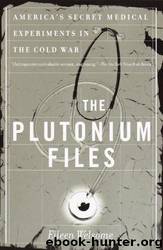The Plutonium Files: America's Secret Medical Experiments in the Cold War by Eileen Welsome

Author:Eileen Welsome
Language: eng
Format: mobi, epub
Tags: Informed Consent (Medical Law), Radiation - Physiological Effect - Research - Moral and Ethical Aspects - United States, Informed Consent (Medical Law) - United States, Radiation - Toxicology - Research - United States, Human Experimentation in Medicine - United States, Human Experimentation in Medicine, Plutonium
ISBN: 0385319541
Publisher: Delta
Published: 1999-01-01T23:00:00+00:00
31
THE INVERTED MUSHROOM
A young Army lieutenant shepherded his platoon into a trench 1,700 yards behind the officer volunteers on the morning that Shot Simon was being readied for detonation. The desert was blanketed in darkness. Two miles away, a small light glowed at the base of the 300-foot tower cradling the bomb. Normally the weapons were exploded about thirty minutes before sunrise.1 That way the flash from the bomb would trip the photoelectric cells that started the recording equipment and give the sampler pilots enough daylight to see the mushroom cloud.
The lieutenant, identified only as S.H., was the last man to march down the ramp into the five-foot-deep trench.2 He had been warned by his commanding officer not to look at the blast. Just twenty-two years old and two months out of officers’ training school, the lieutenant found the temptation irresistible. As the loudspeaker counted down the last seconds, S.H. turned and glanced over his left shoulder. At that very moment, Simon was exploded in a fury of light and sound.
Before the young officer had time to blink, the light flooded into his eyes. His pupils, which were dilated for night vision, instantly absorbed more than fifty times the energy they would have during daylight. The flash bleached his retinas, turning the world white. Momentarily blind, S.H. staggered down into the trench to join his platoon. When his sight began to return, his men resembled white shadows. His vision remained blurred for the rest of the day, and his left eye began to swell. That evening when he tried to read, the print appeared distorted and a spot on the page seemed to move with his eyes. When he reported the problem to the camp medical officer the following day, he was whisked to a hospital in Fort Hood, Texas, immediately.
At the military hospital, he was placed on a salt-free diet and administered cortisone and atropine. The swelling in his left eye decreased markedly. But radiating tension lines soon appeared around the burn, suggesting that he might suffer a retinal detachment in the future. The lieutenant was released from the hospital about four weeks after the accident. Soon after his hospital discharge, he was separated from the service. Branded forever onto his left retina was a small blind spot. When an eye doctor from Brooklyn, New York, examined the young man’s eyes two years later, he discovered something astonishing: The blind spot resembled an “inverted mushroom.”
Long before the inverted mushroom appeared on the young lieutenant’s eye, scientists had been concerned about the flash from the atomic bomb. At Trinity, observers had been cautioned to wait a few seconds before looking at the fireball through pieces of dark welder’s glass. Everyone heeded the instructions except Richard P. Feynman, the future Nobel laureate.3 Feynman climbed into a truck, reasoning that the windshield would protect his eyes from the harmful rays. “I’m probably the only guy who saw it with the human eye,” he later wrote.4 One historian said Feynman was temporarily blinded, but Feynman doesn’t mention such a problem in his autobiography.
Download
The Plutonium Files: America's Secret Medical Experiments in the Cold War by Eileen Welsome.epub
This site does not store any files on its server. We only index and link to content provided by other sites. Please contact the content providers to delete copyright contents if any and email us, we'll remove relevant links or contents immediately.
| Africa | Americas |
| Arctic & Antarctica | Asia |
| Australia & Oceania | Europe |
| Middle East | Russia |
| United States | World |
| Ancient Civilizations | Military |
| Historical Study & Educational Resources |
Cat's cradle by Kurt Vonnegut(14776)
Pimp by Iceberg Slim(13797)
Underground: A Human History of the Worlds Beneath Our Feet by Will Hunt(11846)
4 3 2 1: A Novel by Paul Auster(11810)
The Radium Girls by Kate Moore(11633)
Wiseguy by Nicholas Pileggi(5326)
American History Stories, Volume III (Yesterday's Classics) by Pratt Mara L(5140)
Perfect Rhythm by Jae(5080)
The Fire Next Time by James Baldwin(5025)
Paper Towns by Green John(4807)
Pale Blue Dot by Carl Sagan(4628)
A Higher Loyalty: Truth, Lies, and Leadership by James Comey(4559)
The Mayflower and the Pilgrims' New World by Nathaniel Philbrick(4286)
The Doomsday Machine by Daniel Ellsberg(4250)
Killers of the Flower Moon: The Osage Murders and the Birth of the FBI by David Grann(4194)
Too Much and Not the Mood by Durga Chew-Bose(4098)
The Sympathizer by Viet Thanh Nguyen(4096)
The Borden Murders by Sarah Miller(4028)
Sticky Fingers by Joe Hagan(3916)
